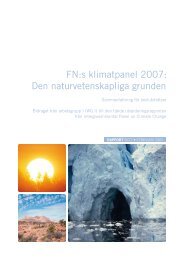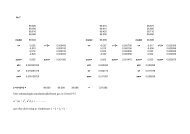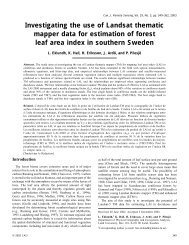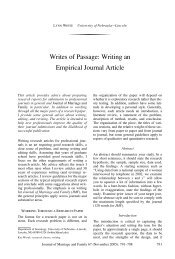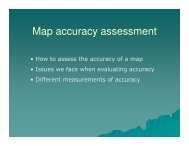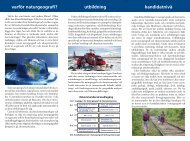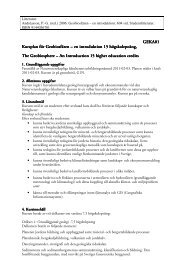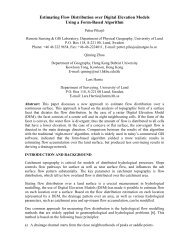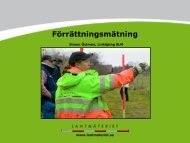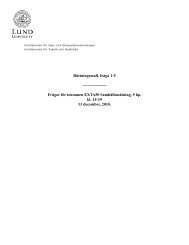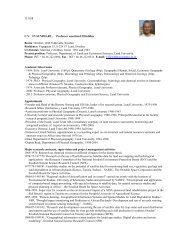Cartography and Map projections Different needs of maps ...
Cartography and Map projections Different needs of maps ...
Cartography and Map projections Different needs of maps ...
Create successful ePaper yourself
Turn your PDF publications into a flip-book with our unique Google optimized e-Paper software.
<strong>Cartography</strong> <strong>and</strong><br />
<strong>Map</strong> <strong>projections</strong><br />
<strong>Different</strong> <strong>needs</strong> <strong>of</strong> <strong>maps</strong> <br />
<strong>Different</strong> map types !<br />
Reference <strong>maps</strong><br />
Thematic <strong>maps</strong><br />
Special <strong>maps</strong><br />
© Copyright 2002 Lund University GIS Centre. All Rights Reserved<br />
What is special with spatial data?<br />
A coordinate system on the model<br />
135°W<br />
150°W<br />
180°<br />
165°E<br />
North Pole<br />
120°W<br />
150°E<br />
They have a position.<br />
105°W<br />
90°W<br />
75°W<br />
135°E<br />
120°E<br />
105°E<br />
Meridians<br />
Longitude<br />
Parallels<br />
Latitude<br />
105°W<br />
120°W<br />
135°W<br />
150°W<br />
180°<br />
165°E<br />
150°E<br />
135°E<br />
Meridians<br />
&<br />
Parallels<br />
Coordinates<br />
x, y (z) in a<br />
coordinate system.<br />
60°W<br />
45°W<br />
30°W<br />
15°W<br />
60°E<br />
45°E<br />
0° 15°E 30°E<br />
75°E<br />
90°E<br />
90°W<br />
South Pole<br />
75°W<br />
60°W<br />
45°W<br />
30°W<br />
15°W<br />
0°<br />
15°E 30°E<br />
45°E<br />
60°E<br />
75°E<br />
120°E<br />
90°E<br />
105°E<br />
A grid net i.e. a<br />
coordinate<br />
system<br />
on the 3D model<br />
Geocentric three-dimensional<br />
Cartesian coordinates<br />
Three dimensional coordinate system with its origo in the<br />
centre <strong>of</strong> the earth model. Convenient to use in computations<br />
but not for presenting coordinates (since it has no direct link to<br />
earth surface).<br />
Z<br />
Earth rotation axis<br />
Greenwich meridian<br />
Y<br />
Definition <strong>of</strong><br />
spherical<br />
latitude<br />
Prime meridian<br />
Geographical coordinates<br />
Expressed in LATITUDE & LONGITUDE<br />
Angles in<br />
degrees º, minutes ’ & seconds ”<br />
from the<br />
equatorial plane &<br />
prime meridian at Greenwich (London)<br />
Earth rotation axis<br />
Latitude<br />
Prime meridian<br />
Earth rotation axis<br />
Latitude<br />
Definition <strong>of</strong><br />
geographic<br />
latitude<br />
X<br />
0<br />
Longitude<br />
0<br />
Longitude<br />
1
Coordinates in lat, long<br />
The shape <strong>of</strong> the Earth<br />
There are 360 º<br />
around the Earth<br />
90º N <strong>and</strong> S<br />
180º E <strong>and</strong> W<br />
1º = 60’ (minutes)<br />
1’= 60” (seconds)<br />
Example:<br />
Lund’s old water tower<br />
long: 13º12’14.00” E<br />
= 13 + 12/60 + 14.00/3600<br />
= 13.203889 degrees<br />
lat: 55º42’42.00” N<br />
= 55 + 42/60 + 42.00/3600<br />
= 55.716667 degrees<br />
Geoid = ”Real” shape <strong>of</strong> the<br />
Earth.<br />
Irregular in shape.<br />
Caused by non uniform<br />
distribution <strong>of</strong> mass inside the<br />
Earth<br />
We need a model<br />
Some common ellipsoids<br />
We need a model – Ellipsoid best<br />
Ellipsoid<br />
Semi major axis = a,<br />
(m)<br />
1/f (flattening)<br />
GRS 80<br />
6 378 137.0<br />
298.257 222 101<br />
WGS 84<br />
6 378 137.0<br />
298.257 223 563<br />
Bessel 1841<br />
6 377 397.155<br />
299.1528128<br />
Clarke 1866<br />
6 378 206.4<br />
294.9786982<br />
Definition <strong>of</strong> an Ellipsoid:<br />
Semi major axis = a<br />
Everest 1830<br />
6 377 276.345<br />
300.8017<br />
Semi minor axis = b<br />
Hayford 1910<br />
6 378 388.0<br />
297.0<br />
Flattening = f<br />
( a − b)<br />
f =<br />
a<br />
International<br />
Krassovsky 1940<br />
6 378 388.0<br />
6 378 245.0<br />
297.0<br />
298.3<br />
ESRI, Underst<strong>and</strong>ing <strong>Map</strong> Projections, 2004<br />
The shape <strong>of</strong> the Earth II<br />
Geoid = Equipotential surface in<br />
the earth gravity field.<br />
Coincides with the mean sea<br />
surface at the oceans.<br />
<strong>Map</strong> <strong>of</strong> the geoid separation<br />
(GRS1980 ellipsoid earth centred)<br />
H = Height above sea level<br />
(from levelling instrument).<br />
+10 +100 m m<br />
Mean Sea level<br />
Topographic Surface<br />
H<br />
h<br />
Geoid<br />
N<br />
Ellipsoid<br />
h = Height above ellipsoid (from<br />
GPS).<br />
N = Geoid height = geoid<br />
separation (computed<br />
from satellite orbit<br />
observations <strong>and</strong> terrestrial<br />
gravity measurements.<br />
00 m<br />
-10 -100 m m<br />
2
Earth centered<br />
ellipsoid (datum)<br />
Geodetic reference systems<br />
or datums<br />
We move the ellipsoid to fit a certain part <strong>of</strong> the Earth<br />
Geoid<br />
Earth center<br />
<strong>of</strong> mass<br />
1. Model <strong>of</strong> the<br />
Earth Geoid <br />
Ellipsoid<br />
2. Coordinate<br />
system on the<br />
Earth model<br />
How do we create a map?<br />
Prime meridian<br />
0<br />
Earth rotation axis<br />
Longitude<br />
Latitude<br />
3. Adjust position<br />
ellipsoid Geoid<br />
4. <strong>Map</strong> projection Flat <strong>Map</strong><br />
5. Plane 2D Cartesian<br />
coordinate system<br />
6. Simplify <br />
Cartographic <strong>and</strong><br />
visualisation<br />
techniques.<br />
Lokal ellipsoid<br />
(datum)<br />
<strong>Map</strong> <strong>projections</strong><br />
Properties <strong>of</strong> map <strong>projections</strong><br />
A method to make the Earth model flat.<br />
All map <strong>projections</strong> implies distortions.<br />
Choose a map projection that suits an<br />
application as good as possible.<br />
= Unavoidable distortions should be<br />
manageable for the applications.<br />
Equal area property<br />
Conformal – (Local) angle preserving<br />
Equidistant along certain lines<br />
Equal area projection<br />
Preserves the relative sizes <strong>of</strong> geographic features.<br />
Distort the shape <strong>of</strong> features.<br />
Conformal<br />
Preserves the local shapes (angles). The relative size <strong>of</strong><br />
geographic features changes.<br />
Reality<br />
<strong>Map</strong><br />
projection<br />
Reality<br />
<strong>Map</strong> projection<br />
3
Equidistance in map <strong>projections</strong><br />
Caution with the term<br />
equidistant map <strong>projections</strong>.<br />
A map projection can be equidistant<br />
for a couple <strong>of</strong> lines, but<br />
no map projection is equidistant along all lines.<br />
The light bulb metaphor<br />
= perspective approach to map<br />
<strong>projections</strong><br />
Geometric shape <strong>of</strong><br />
the map ”paper”.<br />
Placement <strong>of</strong> the<br />
paper ”on” the Earth,<br />
aspect.<br />
Placement <strong>of</strong> the light<br />
bulb.<br />
<strong>Different</strong> <strong>maps</strong>.<br />
ESRI, Underst<strong>and</strong>ing <strong>Map</strong> Projections, 2004<br />
Distortions at a<br />
minimum where the<br />
paper is close to the<br />
Earth.<br />
Basic geometrical shapes<br />
<strong>of</strong> map <strong>projections</strong><br />
Azimuthal<br />
Aspect <strong>of</strong> map <strong>projections</strong><br />
There are three main geometrical<br />
forms <strong>of</strong> map <strong>projections</strong>:<br />
Polar Equatorial Oblique<br />
Planar <strong>projections</strong> (azimuthal <strong>projections</strong>)<br />
Cylindric<br />
Cylindric <strong>projections</strong><br />
Conic <strong>projections</strong><br />
Normal<br />
Transverse<br />
Oblique<br />
Conic<br />
Normal<br />
Normal<br />
Oblique<br />
Secant (cutting) map <strong>projections</strong><br />
Light bulb location (azimuthal)<br />
Azimuthal Secant<br />
Normal cylindric secant<br />
Transverse cylindric secant<br />
ESRI, Underst<strong>and</strong>ing <strong>Map</strong> Projections, 2004<br />
Conic Secant<br />
Gnomonic Stereographic Orthographic<br />
4
Planar <strong>projections</strong><br />
Cylindrical <strong>projections</strong><br />
Conic <strong>projections</strong><br />
<strong>Map</strong> projection shapes <strong>and</strong> properties<br />
Light beam<br />
A<br />
a<br />
To get specific properties <strong>of</strong><br />
the resulting map we need to<br />
modify the light beam.<br />
The direction is changed<br />
when it cuts the Earth<br />
surface on its way from the<br />
light source to the map<br />
(paper).<br />
Central meridian<br />
This is done mathematically.<br />
Projection parameters I<br />
Projection parameters II<br />
Each map projection has it own set <strong>of</strong><br />
projection parameters.<br />
These parameters describe the<br />
details <strong>of</strong> the relationship between the<br />
geographic coordinates <strong>and</strong> the map<br />
projection coordinates.<br />
That is they are necessary to fully<br />
define the function f x <strong>and</strong> f y in:<br />
x =<br />
y =<br />
f<br />
f<br />
x<br />
y<br />
( ϕ , λ )<br />
( ϕ , λ )<br />
Example:<br />
Gauss-Krűger<br />
projection<br />
(Transverse<br />
cylinder)<br />
y<br />
F.E.<br />
False easting – A linear value applied to the<br />
origin <strong>of</strong> the x-coordinates<br />
False northing – A linear value applied to the<br />
origin <strong>of</strong> the y-coordinates<br />
x<br />
Area to be mapped<br />
Central meridian – Defines<br />
where the cylinder touches the<br />
earth model. Also defines the<br />
origin <strong>of</strong> the x-coordinates.<br />
Scale factor – A unitless value applied to the<br />
center point or line <strong>of</strong> a map projection<br />
5
Choice <strong>of</strong> map <strong>projections</strong> I<br />
Choice <strong>of</strong> map <strong>projections</strong> III<br />
Large scale mapping<br />
<strong>Map</strong>ping <strong>of</strong> small areas<br />
Atlases<br />
Some geographic analysis<br />
World <strong>maps</strong> for illustration<br />
Robinson projection<br />
Conformal <strong>projections</strong> should<br />
always be used.<br />
Equal area <strong>projections</strong> is<br />
<strong>of</strong>ten the best choice.<br />
Special projection might be<br />
used (compromise between<br />
equal area <strong>and</strong> conformal<br />
properties)<br />
Which conformal projection is best for a<br />
certain area?<br />
Large area in North-South<br />
direction:<br />
Transverse cylindrical projection<br />
(e.g. Gauss-Krűger or UTM)<br />
Large area in East-West<br />
direction:<br />
Conical projection<br />
(e.g. Lambert Conformal Conic<br />
projection)<br />
Definition <strong>of</strong> the Swedish plane coordinate system<br />
Spherical<br />
coordinate system<br />
on the Earth<br />
105°W<br />
120°W<br />
135°W<br />
150°W<br />
180°<br />
165°E<br />
150°E<br />
135°E<br />
A transverse<br />
cylindrical<br />
projection<br />
90°W<br />
120°E<br />
Coordinates in<br />
latitute<br />
<strong>and</strong><br />
longitude<br />
75°W<br />
60°W<br />
45°W<br />
75°E<br />
90°E<br />
105°E<br />
Parallels <strong>and</strong><br />
meridians are no<br />
longer straight<br />
lines in a Cartesian<br />
coordinate grid<br />
30°W<br />
60°E<br />
15°W<br />
0°<br />
15°E 30°E<br />
45°E<br />
We need a<br />
plane<br />
Cartesian<br />
coordinate<br />
system<br />
15°W 0° 15°E 45°E 60°E<br />
60°N 60°N<br />
45°N 45°N<br />
We define<br />
an origo<br />
15°W 0° 15°E 45°E 60°E<br />
60°N 60°N<br />
45°N 45°N<br />
30°N<br />
30°N<br />
Example:<br />
The Swedish<br />
national<br />
system:<br />
RT90, 2.5<br />
gon W<br />
15°N<br />
15°N<br />
15°N<br />
15°N<br />
0° 0°<br />
0° 0°<br />
15°W<br />
0°<br />
15°E<br />
30°E<br />
45°E<br />
15°W<br />
0°<br />
15°E<br />
30°E<br />
45°E<br />
6
0<br />
0<br />
0<br />
0<br />
0<br />
0<br />
We define<br />
an origo<br />
7500000<br />
-4500000<br />
-3000000 -1500000<br />
0<br />
1500000 3000000<br />
15°W 0° 15°E 45°E 60°E<br />
60°N 60°N<br />
7500000<br />
We define<br />
an origo<br />
7500000<br />
-3000000<br />
-1500000<br />
0<br />
1500000 3000000 4500000<br />
15°W 0° 15°E 45°E 60°E<br />
60°N 60°N<br />
7500000<br />
We create<br />
the grid<br />
6000000<br />
4500000<br />
45°N 45°N<br />
30°N<br />
6000000<br />
4500000<br />
We create<br />
the grid<br />
6000000<br />
4500000<br />
45°N 45°N<br />
30°N<br />
6000000<br />
4500000<br />
We get<br />
negative<br />
coordinates<br />
in western<br />
Sweden !<br />
3000000<br />
1500000<br />
15°N<br />
0° 0°<br />
15°N<br />
3000000<br />
1500000<br />
We move the<br />
north/south<br />
axis far west<br />
<strong>of</strong> Sweden<br />
=<br />
False<br />
Easting<br />
3000000<br />
1500000<br />
15°N<br />
0° 0°<br />
15°N<br />
3000000<br />
1500000<br />
15°W<br />
0°<br />
15°E<br />
30°E<br />
45°E<br />
15°W<br />
0°<br />
15°E<br />
30°E<br />
45°E<br />
-4500000<br />
-3000000<br />
-1500000<br />
0<br />
1500000<br />
3000000<br />
-3000000<br />
-1500000<br />
0<br />
1500000<br />
3000000<br />
4500000<br />
-3000000<br />
-1500000<br />
0<br />
1500000<br />
3000000<br />
4500000<br />
7500000<br />
15°W 0° 15°E 45°E 60°E<br />
60°N 60°N<br />
7500000<br />
RT90, 2.5<br />
gon W<br />
6000000<br />
45°N 45°N<br />
6000000<br />
4500000<br />
30°N<br />
4500000<br />
Plane, cartesian<br />
coordinate system<br />
3000000<br />
15°N<br />
15°N<br />
3000000<br />
National e.g.<br />
RT 90 in Sweden<br />
1500000<br />
0° 0°<br />
1500000<br />
Coordinates in<br />
x <strong>and</strong> y, meters<br />
15°W<br />
0°<br />
15°E<br />
30°E<br />
45°E<br />
-3000000<br />
-1500000<br />
0<br />
1500000<br />
3000000<br />
4500000<br />
Plane,<br />
cartesian<br />
local<br />
coordinate<br />
systems<br />
e.g.<br />
Lund’s<br />
coordinate<br />
system<br />
LUND<br />
Universal Transverse Mercator<br />
UTM<br />
A system <strong>of</strong> map <strong>projections</strong> that is defined over the whole globe.<br />
All the <strong>projections</strong> are conformal.<br />
* In polar region (φ>84 o N or φ>80 o S) a planar polar stereographic<br />
map projection is used.<br />
* In other regions a transverse mercator map projection is used<br />
(cylindrical)<br />
7
UTM II<br />
UTM III<br />
Projection parameters:<br />
Central meridian:<br />
Centred in the current zone.<br />
Scale factor: 0.9996<br />
False Easting: 500 000 m<br />
False Northing:<br />
0 m - Norhern hemisphere)<br />
10 000 000 m – Southern hemisphere)<br />
The End<br />
8



